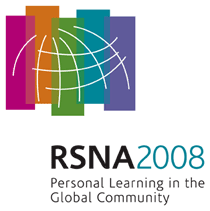
Abstract Archives of the RSNA, 2008
VS41-13
Assessment of the Radial Distribution of Glycosaminoglycans (GAG) in Arthritic Hips Using Delayed Gadolinium-enhanced MRI of Cartilage (dGEMRIC)
Scientific Papers
Presented on December 3, 2008
Presented as part of VS41: Musculoskeletal Series: Cartilage Imaging
Samir Sur BS, MA, Presenter: Nothing to Disclose
Tallal Charles Mamisch MD, Abstract Co-Author: Research Consultant, Siemens AG, Erlangen, Germany
Inge Kress BMedSc, Abstract Co-Author: Nothing to Disclose
Young-Jo Kim MD, PHD, Abstract Co-Author: Nothing to Disclose
The purpose of the current study was to assess the radial distribution of glycosaminoglycan (GAG) content in the hip using a three-dimensional isotropic fast T1 mapping sequence for delayed Gadolinium enhanced MRI of Cartilage (dGEMRIC).
Thirty-five hips in 35 patients presenting with varying radiographic evidence of arthritis in the hip were imaged using a 3D isotropic fast T1 mapping dGEMRIC sequence (TR 15 msec, TE 3.27 msec, flip angles of 4.1 and 23.5 deg., Matrix size 192/192, 16 cm FoV, voxel size 0.8 x 0.8 x 0.8 mm) and a previously validated fast T1 mapping dGEMRIC sequence (voxel size 0.6 x 0.6 x 4 mm) for comparison. For each patient, 3D image data was reconstructed into 9 radial slices spaced 30 deg. apart and oriented orthogonally to the acetabular opening (excluding the fossa). In each slice, a dGEMRIC index was calculated as the mean T1 of the acetabular and femoral cartilage between the vertical center and peripheral edge of the joint, excluding the labrum. Patterns of dGEMRIC index distribution across the 9 radial positions (from anterior-inferior to posterior-inferior) were compared for hips with varying amounts of arthritis.
3D fast T1 mapping sequence measurements correlated well to previously validated sequence measurements (Pearson regression coefficient R2 = 0.958). Radial data was stratified by overall dGEMRIC score (mean of 9 radial dGEMRIC indices) into 4 arthritis grades: grade 3 (n = 5, mean = 293 ms), grade 2 (n = 10, mean = 380 ms), grade 1 (n = 10, mean = 488 ms), and grade 0 (n = 10, mean = 597 ms). A consistent pattern of the highest dGEMRIC index occurring in the superior regions of the joint cartilage was observed in the grade 0-2 hips: mean superior and superior-posterior dGEMRIC indices were significantly greater than overall dGEMRIC scores (p < 0.05). In grade 3 hips, an inverted pattern of GAG distribution was observed: superior regions displayed significantly lower dGEMRIC indices in comparison to overall dGEMRIC scores (p < 0.05).
Using a 3D fast T1 mapping dGEMRIC method to assess the GAG content in local cartilage segments around the acetabulum in vivo, we have reproduced the charge density distribution reported in previous histological studies.
3D dGEMRIC is a powerful diagnostic tool and will enable the in vivo characterization of cartilage degradation in early osteoarthritis in future long-term studies.
Sur, S,
Mamisch, T,
Kress, I,
Kim, Y,
Assessment of the Radial Distribution of Glycosaminoglycans (GAG) in Arthritic Hips Using Delayed Gadolinium-enhanced MRI of Cartilage (dGEMRIC). Radiological Society of North America 2008 Scientific Assembly and Annual Meeting, February 18 - February 20, 2008 ,Chicago IL.
http://archive.rsna.org/2008/6009854.html

